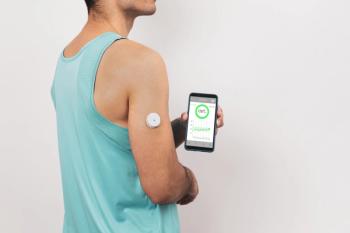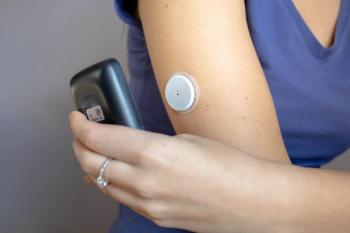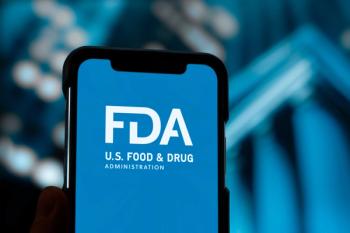Patients with type 1 diabetes (T1D) utilizing real-time and intermittently scanned continuous glucose monitoring (CGM) systemshad a significant decrease in hemoglobin A1c (HbA1c) compared with patients who self-monitored their blood glucose levels, according to the results of a randomized control cross-over study.1 The findings were published in Diabetes Research and Clinical Practice.
Since the invention of CGM systems in 19922, several clinical trials have proven its superiority to self-monitoring of blood glucose (SMBG).1 However, in this study, researchers aimed to assess the differences in the 2 types of CGM— real-time CGM (rt-CGM) and intermittently scanned (is-CGM)—with SMBG.
An rt-CGM system automatically transmits a continuous stream of glucose data to the user and can provide alerts and active alarms. In addition, rt-CGM can transmit glucose data in real time to another device. An is-CGM system is similar, but the user has to purposely scan the sensor for information. In addition, is-CGM systems do not have alerts and alarms.3
Key Takeaways
- Researchers further analyzed the two types—real-time and intermittenly scanned—of CGM in a short-term duration.
- CGM was deemed significantly more successful than self-monitoring for short-term glycemic benefit.
- They found that rt-CGM and is-CGM were comparable in their benefits but still superior to self-monitoring blood glucose levels.
Study participants included 68 patients with T1D (mean age 20.3 years, mean HbA1c 9.1, and mean duration of diabetes 7 years) separated into 3 groups based on their type of monitoring: SMBG, rt-CGM, and is-CGM.1
During the trial, individuals in the rt-CGM and is-CGM groups were swapped after 3 months, while SMBG participants continued self-monitoring.
To assess the short-term effectiveness of CGM, participants in both the rt-CGM and is-CGM groups were asked to monitor for 2 weeks at the start of the study and 2 weeks after the groups crossed over.
Participants were split into groups based on a ratio of 1:1:2, with 17 participants each in the rt-CGM and is-CGM groups and 34 in the SMBG group.
READ MORE: Addressing The Need for Better Access to CGM in Low-Income Areas
“Out of a total 68 T1D patients, HbA1c decreased significantly in groups A [rt-CGM to is-CGM] and B [is-CGM to rt-CGM] at 6 months compared to the baseline, but not in group C [SMBG],” wrote the authors.1 “HbA1c was significantly lower in Group A compared to Group C at 3 and 6 months.”
In other words, individuals using either type of CGMS experienced significant HbA1c decreases compared with the SMBG group. Furthermore, when comparing is-CGM with rt-CGM, participants who switched from rt-CGM to is-CGM at 3 months saw the most significant decrease.
Researchers’ secondary objectives for this study aimed to assess specific CGM parameters (percentage of time above, below, and in glucose level range) as well as change in plasma fructosamine.
Regarding CGM parameters, patients who switched from is-CGM to rt-CGM showed significantly better time above and in range, while the percentage of time spent in hypoglycemia (TBR) was also significantly less.1
Furthermore, when measuring each group’s change in plasma fructosamine, individuals going from is-CGM to rt-CGM experienced a significant decrease.1
“Rt-CGMS improved the number of hypoglycemic events and duration of hypoglycemia as measured by TBR. Maximum benefits on glycemic variability and TAR and TBR were seen when patients with T1D were switched from is-CGMS to rt-CGMS,” wrote the authors.1
The authors considered rt-CGM and is-CGM as comparable based on their results1, because they were both significantly more effective than SMBG, but in specific ways; is-CGM had a beneficial effect on HbA1c at 3 and 6 months and rt-CGM improved hypoglycemic events.1
The cross-over study design gave researchers a greater ability to analyze the short-term uses of CGM, but in a long-term setting with 3- and 6-month check-ins over 3 years (May 2021 to April 2023). Their findings support the claim in several previous studies that CGM systems are the ideal technology to manage blood glucose levels.1
READ MORE: Community Pharmacist-Led CGM Programs Can Boost Clinic Revenue While Helping Patients
References
1. Gupta A, Mukherjee S, Kumar Bhadada S, et al. Impact of short-term application of continuous glucose monitoring system (CGMS) on long-term glycemic profile in adolescents and adults with type 1 diabetes mellitus: an open-label randomized control cross over study. Diabetes Res Clin Pract. doi:10.1016/j.diabres.2024.111610
2. Didyuk O, Econom N, Guardia A, Livingston K, Klueh U. Continuous glucose monitoring devices: past, present, and future focus on the history and evolution of technological innovation. J Diabetes Sci Technol. 2021;15(3):676-683. doi:10.1177/1932296819899394
3. Edelman SV, Argento NB, Pettus J, Hirsch IB. Clinical implications of real-time and intermittently scanned continuous glucose monitoring. Diabetes Care. 2018;41(11):2265-2274. doi:10.2337/dc18-1150







































































































































